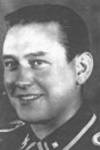Kurt Bolender
Heinz Kurt Bolender (born May 21, 1912 in Duisburg ; † October 10, 1966 in Hagen ) was a German SS-Oberscharführer and was involved in " Aktion T4 " and " Aktion Reinhardt " as well as in the suppression of the Sobibór uprising. He was charged with his crimes before the Hagen district court. Shortly before the sentencing was announced, he committed suicide while in custody.
Life
Kurt Bolender, a professional iron inspector, a member of the NSDAP and SS , came in 1939 by the SS Death's Head units to SS Division Totenkopf . Soon afterwards he was sent from there to “Aktion T4” and was employed as a “corpse incinerator” in various “euthanasia” institutions ( Hartheim , Hadamar , Brandenburg and Sonnenstein ). In the winter of 1941/42 Bolender was deployed on the Eastern Front in the Soviet Union to transport the wounded and from there in the spring of 1942 came to "Aktion Reinhardt".
Action Reinhardt
Following Franz Stangl's entourage , Bolender arrived at the Sobibor extermination camp on April 22, 1942 . In Sobibor, Bolender was initially head of Camp III ("Totenlager") and also supervised the Jewish work details. In autumn 1942 he took over the management of the Trawniki guards in Sobibor. In December 1942, Bolender was sentenced to imprisonment in the SS prison camp in Danzig-Matzkau by an SS and police court in Kraków for inciting a witness to perjury in his divorce proceedings. After the armed uprising in Sobibor on October 14, 1943, he was reinstated in Sobibor as part of the liquidation of the camp. Then he was employed in the SS labor camp Dorohucza near Lublin and the German equipment works. Probably it was in early 1944 in the Operational Zone of the Adriatic Littoral to the special section insert R for Trieste added that the "extermination of the Jews," the confiscation of Jewish property and the anti-partisan served. In January 1945 Bolender was awarded the Iron Cross 2nd class . In the course of the approaching end of the war, the units of the "Sonderabteilung Einsatz R" withdrew from northern Italy at the end of April 1945 and Bolender returned to Germany.
post war period
After the war, Bolender first went into hiding under the false name "Heinz Brenner", as an adaptation to his previous job as a corpse incinerator, and later obtained forged papers in Carinthia in the name of "Wilhelm Kurt Vahle". His fiancée, a former T4 employee, with whom he lived near Hamburg from November 1945, had him (as Kurt Bolender) officially declared dead. At the beginning of the 1950s he was registered in Hamburg, where he received an identity card in the name of “Vahle” and later a corresponding passport . For camouflage reasons, a place in East Prussia was given as the place of birth. In the 1950s, Bolender alias Vahle worked as a porter in the Hamburger Hofbräuhaus and the Er- und Siebar in Hamburg. Bolender, who was friends with Dietrich Allers , the former T4 employee and supervisor of the “Special Department Operation R” , was also represented by Allers as a lawyer. The law enforcement authorities were able to determine his identity and whereabouts and so he was arrested in May 1961. In his accommodation the police found his whip with the silver initials KB, made by the Sobibor survivor Stanisław Szmajzner . In the Sobibor trial , which took place from September 6, 1965 to December 20, 1966 before the Hagen District Court , Bolender was charged with complicity in the joint murder of at least 86,000 people and murder in at least 360 cases. Bolender, who initially stated his activity in the process with fighting partisans in the area around Lublin, only confessed to his actions in Sobibor after cross-examination. Sobibor survivor Moshe Bahir described Bolender as extremely brutal and sadistic. Before the sentencing was announced, Bolender committed suicide by hanging in custody on October 10, 1966.
literature
- Ernst Klee : "Euthanasia" in the Nazi state . 11th edition. Fischer-Taschenbuch, Frankfurt am Main 2004, ISBN 3-596-24326-2 .
- Ernst Klee: What they did - what they became. Doctors, lawyers and others involved in the murder of the sick or Jews . 12th edition. Fischer-Taschenbuch, Frankfurt am Main 2004, ISBN 3-596-24364-5 .
- Ernst Klee: The dictionary of persons on the Third Reich. Who was what before and after 1945 . Updated edition. Fischer-Taschenbuch, Frankfurt am Main 2005, ISBN 3-596-16048-0 .
- Yitzhak Arad : Belzec, Sobibor, Treblinka - The Operation Reinhardt Camps. Indiana University Press, Indiana, 1987, ISBN 0-253-21305-3 .
Web links
- Short biography of Kurt Bolender on deathcamps.org (English)
| personal data | |
|---|---|
| SURNAME | Bolender, Kurt |
| ALTERNATIVE NAMES | Brenner, Heinz; Vahle, Wilhelm Kurt |
| BRIEF DESCRIPTION | German SS officer, involved in “Aktion T4” and “Aktion Reinhardt” |
| DATE OF BIRTH | May 21, 1912 |
| PLACE OF BIRTH | Duisburg |
| DATE OF DEATH | October 10, 1966 |
| Place of death | Hagen |
